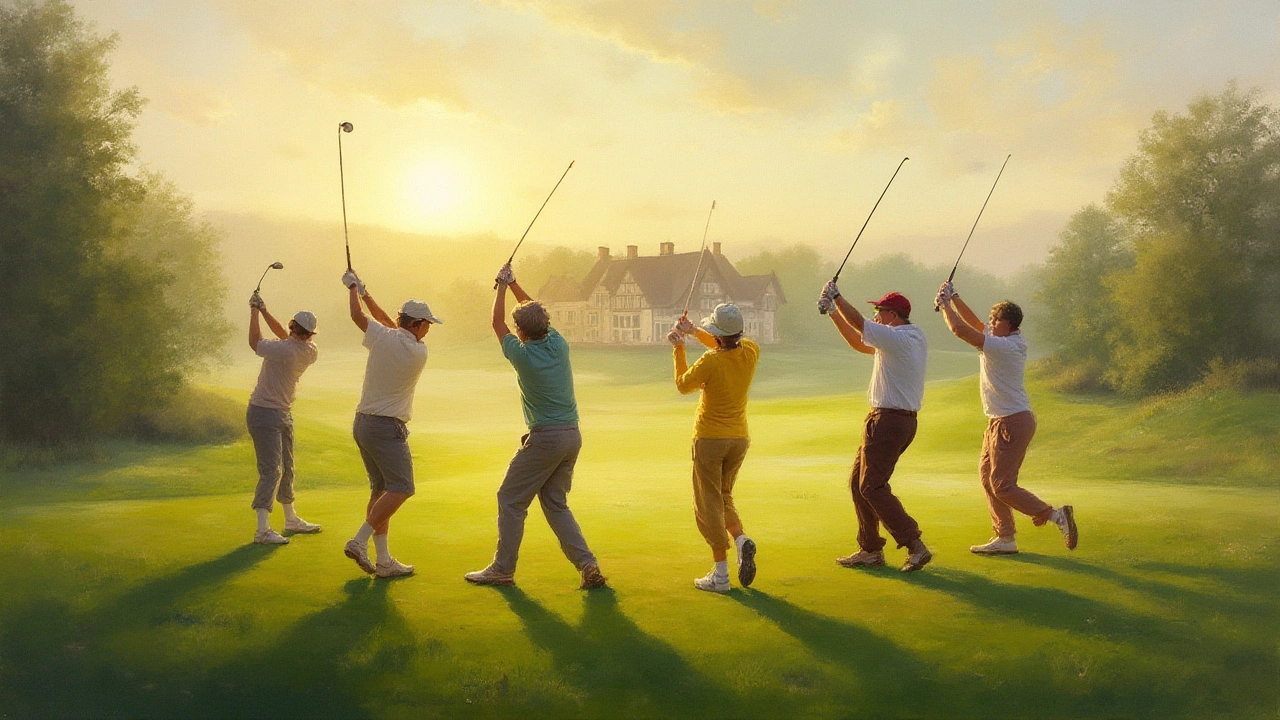Golf Shot Names Explained: Understanding Every Type of Golf Stroke

If you’ve ever stood on a tee box and wondered what people are calling your swing, you’re not alone. Golf is full of odd names for pretty much every shot you can imagine. It can get confusing fast, whether you’re new to golf or just want to sound like you know what you’re talking about in the clubhouse. But here’s the crazy thing: each name makes sense once you dig in. Let’s uncover what a golf shot is called—and why you’ll hear so many different labels tossed around the course.
The Basics: What Do We Call A Golf Shot?
In its simplest form, any attempt to strike the golf ball and move it toward the hole is called a "stroke" or a "shot." These are the building blocks of golf and come with a host of nicknames and distinctions. Calling it a “stroke” is technically correct, based on golf’s official rules. Scoring is even based on counting your strokes. Every swing—whether you nail the ball or completely whiff—counts as a stroke, except when playing a practice swing.
But out on the fairway, you hear folks break it down more specifically. For many, a “shot” is the act of hitting the ball toward a particular target, while a “stroke” is more about scoring. But in everyday talk, they’re often used interchangeably. If someone asks how many shots you took on a hole, most people will tell you how many swings, not the technical rulebook answer.
From here, things get interesting. Each shot you take—from tee to green—gets its own quirky nickname or label. These aren’t just for fun. The name tells you where, how, and even why the ball was hit a certain way. Let’s start with the main types and where you’ll use them on the course.
Types of Golf Shots: From Tee to Green
Golf shots can be grouped by where you play them: tee shots, fairway shots, approach shots, and shots around the green. Each has its own lingo, and regulars will spot the difference instantly. Here’s how it breaks down:
- Drive: This is your first shot on a hole, when you whack the ball from a tee box (usually with a driver). Drives are meant for distance. If you’ve ever felt the rush of hitting a ball dead-center and seeing it rocket down the fairway, you know why golfers love talking about their drives.
- Iron Shot: After your drive, most shots in the fairway or rough are hit with irons. You’ll hear terms like “long iron” or “short iron,” depending on the club. A 4-iron shot will travel farther and lower, while an 8-iron will pop up higher and land softer.
- Approach Shot: This is the term for any shot meant to hit the green and set up a putt. It’s not a specific swing, but more about the intention. Approach shots are usually played with mid or short irons, hybrids, or wedges—whatever puts you within putting range.
- Chip Shot: If you’re close to the green but not on it, you’ll likely chip. Chipping sends the ball just over the grass, bouncing and rolling toward the hole. Most chips are hit with a wedge or 9-iron and need soft hands, not brute force. It’s the shot you use when power isn’t the answer, but precision is.
- Pitch Shot: Pitches are like longer chips, high and soft, usually from about 30–70 yards away. The idea is to fly the ball onto the green and have it stop fast to avoid rolling out too far. Skilled golfers can pitch a ball gently so it doesn’t run past the flag.
- Putt: Once on the green, everything changes. You grab the putter and roll the ball across the grass into the cup. Putts don’t leave the ground unless you really mess up (don’t ask me how I know). Reading slopes, pace control, and nerves of steel—putting tests the whole package.
Every shot has its own technique, vibe, and potential for disaster. But calling the shot by its proper name shows you’re paying attention—a big deal whether you’re in a competitive tourney or just goofing off with friends on a lazy Sunday.

Specialty Golf Shots: The Ones You Brag—or Complain—About
Golf wouldn’t be golf without the weird, wonderful, and sometimes maddening specialty shots. Some are heroic; others are infamous for making you want to snap your club in half. Either way, people talk about these shots more than anything. Here are a few that run the gamut, from legend to nightmare:
- Fade & Draw: These are the bread and butter of shot-shaping. A fade curves gently from left to right (for right-handed golfers), and a draw curves the opposite way, from right to left. Tour pros master these so they can dodge trees or attack tucked pins.
- Hook & Slice: The evil twins of draw and fade. A hook is an extreme right-to-left ball flight (for righties), where you lose control. A slice is the dreaded left-to-right curve that usually leaves you hunting in the woods.
- Punch Shot: Low branches ahead? You punch the ball—hitting it with a short swing to keep it beneath the trees. Jack Nicklaus was a master at this, and it’s saved many a round.
- Flop Shot: Phil Mickelson made the flop shot famous. It’s a high, soft shot over hazards or bunkers, landing softly and stopping fast. Not for the faint of heart; get it wrong, and you might blade the ball 50 yards past the pin.
- Bunker Shot: Sand traps deserve their own shot names. An explosion shot blasts the ball out of a greenside bunker. A fairway bunker shot is struck cleanly with an iron, hoping to avoid digging deep into the sand.
- Recovery Shot: When you’re in trouble—behind a tree, in the rough—these shots are all about getting back into a good spot, often with wild swings or awkward stances.
- Lay-up: Sometimes, going for glory is a bad idea. Laying up means choosing a shorter, safer shot to avoid hazards, setting yourself up for a better next shot. This move doesn’t get the glory, but it saves strokes.
- Shank, Duff, Top, and Whiff: These are the shots we don’t brag about. A shank rockets sideways off the hosel. Duffing means hitting the ground before the ball, moving it barely forward. Topping skips it weakly along the turf. Whiffing means you miss altogether. If this is happening a lot, don’t be afraid to take a lesson—everyone has bad days!
The names don’t just describe the ball flight—they tell a story. You’ll hear someone say, “I punched out from under the oak, hit a fairway wood, then chipped in for par.” Suddenly, a boring scorecard tells an epic golf story.
Pro Tips and Fun Facts: Getting the Most from Your Golf Shots
If you really want to get these shots right—and impress your playing partners—it’s not just about knowing the names. Here’s where the good stuff comes in: the details, tips, and fascinating facts that can help you actually play (and talk) like a seasoned golfer.
- Club Selection Matters: The difference between a pitch and a chip isn’t just distance. It’s also about club choice. Get comfortable with your wedges, and practice low bump-and-run shots versus high soft landings.
- Shot Naming Can Change with the Region: Scots might use older terms (like “brassie” for a 2-wood or “niblick” for a wedge). Some American clubs still celebrate these traditions with fun tournaments.
- Caddie Wisdom: Experienced caddies don’t just carry your bag—they help pick your shot for the situation. Watch how tour players communicate with their caddies for clues about strategic shot naming and selection.
- Golf Shot Stats: According to the PGA Tour, players average about 12–13 fairways hit per round, and a typical 18-hole round involves over 30 putts. That means getting cozy with both long game and short game shots matters way more than only chasing distance.
- Practice Under Pressure: The shots you practice most are the ones you’ll rely on. Spend some time with flop shots, punch shots, and bunker shots. Mastery in these weird spots can save your scorecard.
- Ball Flight and Stance: Understanding how your setup affects the shot lets you shape shots more predictably. Want a fade? Open your stance and grip very slightly. Draw? Do the opposite.
- Distance Control: Professional golfers obsess over how far every shot travels. Carry a rangefinder or make mental notes about distances. This helps you pick the right club (and shot name!) for the job.
- Mental Tricks: Naming your shot before you swing—“I’m hitting a soft draw”—can boost confidence and focus. The brain loves specifics, and it calms nerves.
- Lingo for Fun: Don’t pass up the chance to use golf slang. If you birdied a hole with a crazy chip, say you “got up and down.” Hit a long putt? That’s a “bomb.” Sink a short putt with pressure? That’s a “knee-knocker.”
- History Is Cool: Some shot names go back a century or more. The “bump-and-run” dates to the Scottish links, where players had to keep the ball low due to strong winds and hard ground.
The next time you hit the course, call out your shot with style. There’s real power in naming your shot—the pros do it, your buddies do it, and now you know the inside scoop. Master these, and you’ll not only talk a great game, you might just play one too. And when someone asks, “What is a golf shot called?” you’ll know: it’s called whatever you make it, as long as you swing and give it your best.




